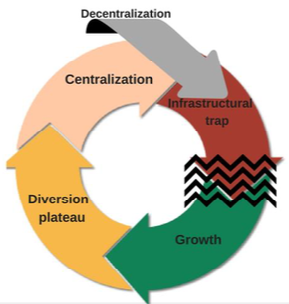
Rivers flow to the sea, except when they don't. The Colorado River hasn't regularly reached the Gulf of California since the completion of the Glen Canyon Dam in 1963. This condition is known as River Basin Closure, a problem that affects the 40 million water users of the Colorado River.
This policy brief details the theory and management issues that underly River Basin Closure as described by Linda-Estelí Méndez, a UC Davis Ecology graduate student who studies social- ecological systems. She also presents related problems of groundwater use by Colorado River users since River Basin Closure. This provides context for improving management and policy outcomes of the Colorado River Basin and its water users.
The development of water resources, also known as hydraulic development, has profoundly shaped both the Colorado River and the many regions that depend on water from the river. Human overexploitation of the Colorado River and River Basin Closure created a new framework for policy and management. Donald Worster describes this framework in his 1982 book Hydraulic Society in California: An Ecological Interpretation. This framework, described as a "hydraulic society," is dominant in the American West.

A hydraulic society, according to Worster, is an intensely managed landscape dominated by concrete. Irrigation canals replace natural rivers and streams, leaving no place, in Worster's terms, for willows, herons, or blackbirds. In the American west, the discovery of gold in 1848 catalyzed the development of a hydraulic society. Miners pouring into the region grew crops for food, and natural systems grew increasingly managed. Infrastructure served as a way for white settlers to claim lands occupied by Native Americans whose infrastructure was far less permanent than concrete. Water infrastructure became a form of state-creation by white settlers via the mobilization of concrete to dominate nature. New cities
such as Los Angeles boomed; they were fueled by what was viewed at the time as inexhaustible resources, including water from the Colorado River.
According to Worster, a society dependent on infrastructure leads to an "infrastructure trap" where dams and irrigation dictate management of natural resources. The infrastructure trap also leads to a path dependency which favors historical practices even when new, more efficient methods become available. As populations grow, intensifying human needs led to periodically exhausting water resources, termed a "diversion plateau" by Worster. Overcoming the plateau requires innovation in the form of more complex hydraulic machinery. This requires a consolidation of power, where government increasingly becomes the primary decision-maker. In the American West, future president Herbert Hoover presided over the development of water infrastructure. He supported centralization of power, which facilitated financial resources for water infrastructure and, later, job creation after the Great Depression. Today the federal Bureau of Reclamation alone operates 320 water-storage reservoirs, 344 diversion dams, about 900 miles of pipelines, and 205 miles of tunnels.
Since River Basin Closure, water users who could not get enough river water have started pumping groundwater. Groundwater is a common pool resource that can be overexploited without proper management. Méndez describes a common pool resource like a glass of water that many users have their straws in. In this case, however, the glass is opaque; users do not see overexploitation happening until it is too late. Unlike surface water, ground water does not require coordination between users (such as irrigation infrastructure) for distribution. In fact, distribution of surface water can create community. Irrigation districts act as community centers and powerful lobbies. The community created through irrigation also sows divisions that we see today in Northern vs. Southern California water users and rural vs. urban water users.
Extraction of groundwater, however, favors individuals over community. This gives an advantage to wealthy water users who have more means to extract. Because gain is short-term, each user is incentivized to pump as much water as possible. In this way, wealth breeds more wealth. Although attempts have been made to manage groundwater resources, progress is slow. Arizona expects to have sustainable groundwater extraction by 2025, and California's goal for sustainable groundwater extraction is even further off in 2040. As humans shifted to extraction of groundwater, this second wave of development created another form of basin closure. We are trapped in a cycle of poor socio-ecological outcomes unless we change our approach to water management as a society.
Despite major challenges for both surface water and groundwater use in and around the Colorado River, social-ecological theory provides a context for improving management of water resources. Worster's theory is a useful context for understanding today's hydro-landscape but should be updated. Successful approaches for managing common pool resources do exist. For example, Nobel Prize-winning economist Elinor Ostrom was active in this field until her death in 2012. Theory developed by Ostrom, Worster, and others may indeed be the key to navigating out of the challenges of River Basin Closure created in 1963 by the Glen Canyon Dam.
